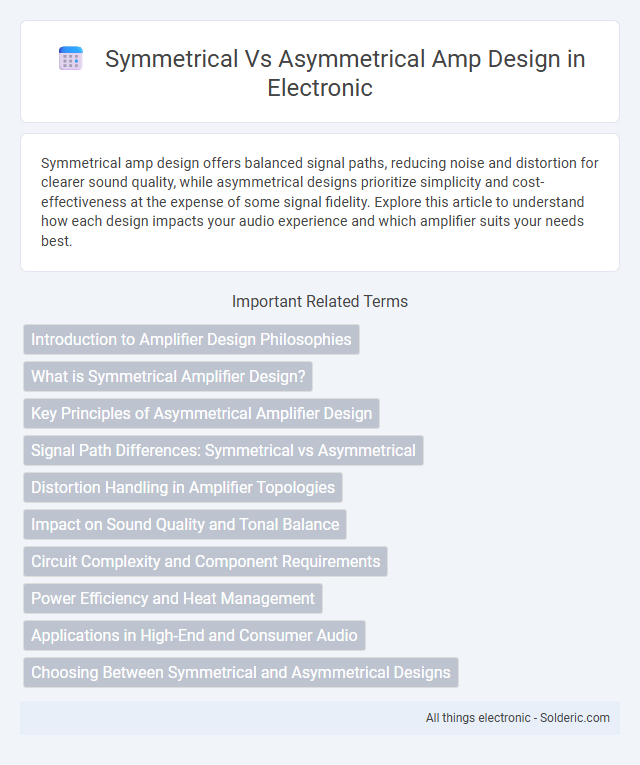Symmetrical amp design offers balanced signal paths, reducing noise and distortion for clearer sound quality, while asymmetrical designs prioritize simplicity and cost-effectiveness at the expense of some signal fidelity. Explore this article to understand how each design impacts your audio experience and which amplifier suits your needs best.
Comparison Table
| Feature | Symmetrical Amplifier Design | Asymmetrical Amplifier Design |
|---|---|---|
| Topology | Identical signal paths for positive and negative halves | Different signal paths or components for positive and negative halves |
| Signal Distortion | Lower even-order harmonic distortion | Higher even-order harmonic distortion |
| Linearity | Generally higher linearity | May have uneven linearity |
| Complexity | More complex design and matching components | Simpler design but less balanced |
| Efficiency | Moderate efficiency | Potentially higher efficiency due to component variation |
| Application | High-fidelity audio and precision electronics | Cost-sensitive or size-constrained applications |
| Noise Performance | Better noise rejection and stability | Higher noise susceptibility |
Introduction to Amplifier Design Philosophies
Symmetrical amplifier design emphasizes matching amplification stages on both signal paths to minimize distortion and enhance linearity, resulting in balanced signal processing. Asymmetrical amplifier design prioritizes simplicity and efficiency by using different circuit topologies on each side, often leading to varied performance characteristics between channels. These contrasting philosophies influence overall sound quality, circuit complexity, and power consumption in audio amplification systems.
What is Symmetrical Amplifier Design?
Symmetrical amplifier design refers to a layout where the circuit components and signal paths are mirrored to achieve balanced performance and minimize distortion. This design enhances signal fidelity by ensuring equal impedance and phase characteristics on both sides, making it ideal for differential signal amplification. Engineers favor symmetrical designs in audio and RF amplifiers to improve linearity and reduce noise, resulting in clearer and more accurate output.
Key Principles of Asymmetrical Amplifier Design
Asymmetrical amplifier design centers on optimizing transistor operation by using different devices or biasing methods for the positive and negative halves of the waveform, enhancing efficiency and reducing distortion. Key principles include tailoring load lines and impedance levels for each half-cycle and carefully managing crossover distortion through complementary but not identical transistor pairs. Your audio system benefits from increased linearity and power efficiency when asymmetrical design principles are effectively implemented.
Signal Path Differences: Symmetrical vs Asymmetrical
Symmetrical amplifier design features balanced signal paths that maintain equal impedance and phase for both positive and negative signals, minimizing noise and distortion. Asymmetrical amplifier design uses an unbalanced signal path where one side carries the signal while the other is grounded, which can introduce greater noise and harmonic distortion. The symmetrical approach is preferred for high-fidelity audio applications due to its superior common-mode noise rejection and cleaner signal transmission.
Distortion Handling in Amplifier Topologies
Symmetrical amplifier designs offer balanced distortion handling by minimizing even-order harmonics, resulting in cleaner, more linear output ideal for high-fidelity audio applications. In contrast, asymmetrical amplifier topologies tend to produce more even-order distortion, which can add warmth or character to your sound but may reduce overall linearity. Your choice between these designs depends on whether you prioritize precision or tonal color in distortion performance.
Impact on Sound Quality and Tonal Balance
Symmetrical amplifier design offers balanced signal processing, reducing distortion and enhancing sound clarity, resulting in a more natural and accurate tonal balance. Asymmetrical designs often introduce intentional harmonic coloration or warmth, which can enrich the musical character but may affect transparency. Understanding your preference for purity versus tonal coloration helps determine which amp design best complements your sound quality expectations.
Circuit Complexity and Component Requirements
Symmetrical amp designs typically feature balanced circuit layouts that require matched components to maintain signal integrity and reduce distortion, increasing overall complexity and cost. Asymmetrical designs use fewer components with simpler configurations but may introduce more harmonic distortion due to unbalanced signal paths. Understanding these differences helps you select the appropriate amplifier design based on performance needs and budget constraints.
Power Efficiency and Heat Management
Symmetrical amplifier designs typically offer better power efficiency by evenly distributing electrical load, which helps minimize energy loss and reduces heat generation during operation. Asymmetrical designs may generate more heat due to uneven current flow, requiring enhanced cooling solutions to maintain performance and prevent thermal damage. Optimizing your amp choice based on these factors can lead to improved durability and sustained audio quality.
Applications in High-End and Consumer Audio
Symmetrical amplifier designs offer superior performance in high-end audio systems by minimizing distortion and enhancing sound clarity, making them ideal for audiophiles seeking precise audio reproduction. Asymmetrical amplifier designs are commonly used in consumer audio products due to their cost-effectiveness and efficiency, delivering satisfactory sound quality for everyday listening experiences. Your choice between symmetrical and asymmetrical amps should align with your audio preferences and budget, especially when balancing fidelity and practicality in different audio applications.
Choosing Between Symmetrical and Asymmetrical Designs
When choosing between symmetrical and asymmetrical amplifier designs, consider your audio goals and space constraints, as symmetrical amps offer balanced signal paths that reduce distortion and improve sound clarity, while asymmetrical designs can provide unique tonal characteristics and potentially better efficiency. Your decision should also reflect the specific application, such as studio sound accuracy favoring symmetrical designs versus custom setups benefiting from asymmetrical flexibility. Understanding these distinctions helps optimize your audio performance and system integration.
Symmetrical vs Asymmetrical amp design Infographic

 solderic.com
solderic.com